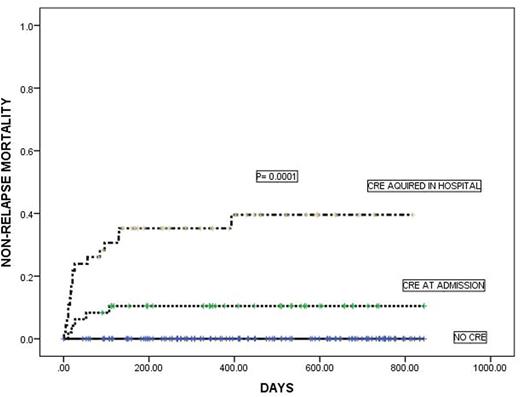Abstract
CRE is the major concern in the patients suffering from hematological malignancy but the data on the impact of colonization in such patients is scarce. We conducted a prospective surveillance study of CRE on 225 patients of haematological malignancies (HM), who required hospital admission between October 2013 to January 2016. The median age of the cohort was 45 years(range,2-84). The cohort included a broad representation of diseases; AML (n=58), ALL(n=44), Lymphoma (n=76), Myeloma(n=22), CML(8) and Others (n=17). Rectal swabs were taken for cultures in all patients during first day of admission and repeated subsequently on weekly basis for continuous hospital stay or in subsequent admissions.47 (21%) patients were colonized with CRE on admission. This increased to 45% on prolonged hospital stay/ contact for more than 4 weeks with 72 (32%) patients being colonized overall. The highest number of patients colonized with CRE at diagnosis was those with AML (30%). The non-relapse mortality (NRM) of the cohort at 6 months was 10.3%. This was 14% in those with acute leukemia compared to 5.8% in others (p=0.02). Furthermore, this was highest in patients with AML (22.9% vs 6.1% in others; p=0.001). CRE related events accounted for 77% of mortality. NRM was 29.6% in those colonized with CRE during hospitalization compared to 10.5% in those colonized at admission with no NRM in those not colonized with CRE (p=0.0001). Amongst patients with AML, colonization with CRE during hospitalization was associated with a NRM of 54.9%(95%CI 32.4-67.4%) compared to those colonized at admission(11.8; 95%CI 4.0-19.6) and those not colonized(0%)(p=0.0001). This trend was true for patients without AML as well (27.3% vs 10.3% vs 0%; p=0.0001). On multivariate analysis, colonization with CRE during hospitalization was the most important risk factor for NRM in patients with hematological malignancies (HR-7.1; 95%CI 3.1-16.1). Our data demonstrates that a substantial proportion of patients with HM are colonized with CRE without prior hospitalisations but those with nosocomial colonization have the highest risk of mortality, particularly in those with AML.
No relevant conflicts of interest to declare.
Author notes
Asterisk with author names denotes non-ASH members.


This feature is available to Subscribers Only
Sign In or Create an Account Close Modal